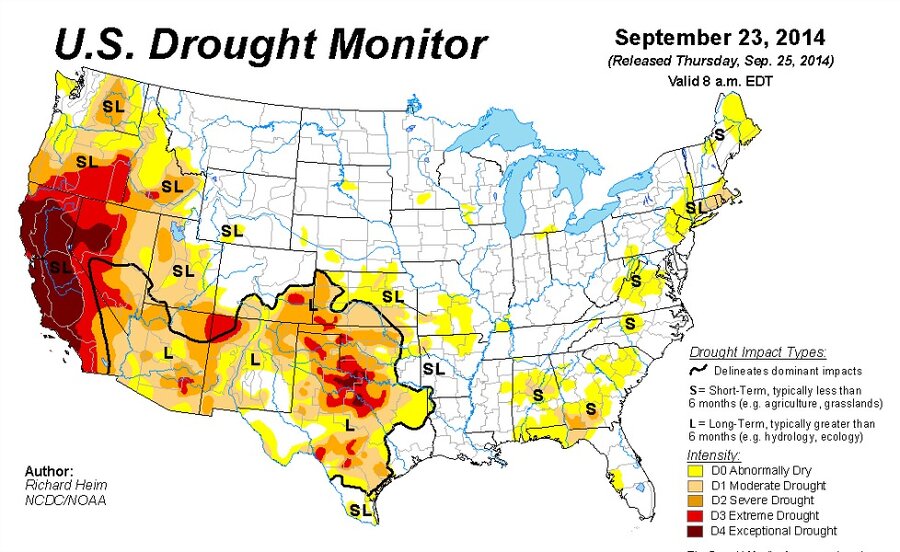Rain dampens California fires, but more drought in the forecast
Loading...
Rain has come as a relief to exhausted firefighters and worried homeowners focused on California’s major wildfires. But the relief may be short-lived.
The 2014 fire season is not over. In recent years, in fact, the season has been starting earlier and going later to the point where it is nearly year-round. And around the West, state officials and climatologists warn that the drought fueling such wildland fires blazing toward and sometime through inhabited areas is likely to persist for months if not years.
Across much of California, the latest US Drought Monitor map is red and dark red, showing “extreme” and “exceptional” drought conditions. This weekly map of drought conditions is produced jointly by the National Oceanic and Atmospheric Administration, the US Department of Agriculture, and the National Drought Mitigation Center at the University of Nebraska-Lincoln.
The red extends north into southern and eastern Oregon and east into Nevada, and splotches of red mark New Mexico and Texas. But it’s California that’s been hardest hit, and it’s likely to be the state with the most to worry about.
“The first eight months of the year were the warmest on record in California, and that heat is exacerbating one of the most devastating droughts in state history,” The Desert Sun newspaper in Palm Springs, Calif., reports. “Water levels in reservoirs have fallen so low that water deliveries for agriculture and communities have been severely curtailed or cut entirely.”
Agriculture meteorologist Scott Borgioli tells the newspaper that there's a high probability California could have below-average rainfall for the entire rain season, which runs from July 1 of this year to June 30 of next year.
"We will not have enough storage in the reservoirs to carry us over, as we did this year," Borgioli said.
The Los Angeles Times reports this week that 14 communities are “on the brink of waterlessness.”
Since January, 28 small California communities have cycled onto and off of a list of "critical water systems" that state officials say could run dry within 60 days, according to this report. “Amid the drought that is scorching the state and particularly the Central Valley, the State Water Resources Control Board decided this year, for the first time ever, to track areas on the brink of waterlessness.”
Today, experts talk of “megadroughts” defined by their longevity. USA Today reports:
“The dryness in California is only part of a longer-term, 15-year drought across most of the Western USA, one that bioclimatologist Park Williams said is notable because ‘more area in the West has persistently been in drought during the past 15 years than in any other 15-year period since the 1150s and 1160s’ – that's more than 850 years ago.
"When considering the West as a whole, we are currently in the midst of a historically relevant megadrought," said Williams, a professor at the Lamont-Doherty Earth Observatory of Columbia University in New York.”
Meeting in Oklahoma recently, the Western Governors’ Association held its first drought forum.
"In Oklahoma we’ve been experiencing drought since the fall of 2010,” Gov. Mary Fallin (R) told the group. “Recent rains have reduced the severity and size of the drought, but still 70 percent of our state is experiencing some level of drought right now.”
As summer becomes autumn, recent rains are helping firefighting efforts in California.
The so-called King Fire in the Sierra Nevada foothills was 68 percent contained Friday morning, according to the California Department of Forestry and Fire Protection (CalFire). The blaze has burned more than 150 square miles in El Dorado County east of Sacramento but barely grew over the past 24 hours.
More than 8,000 firefighters were battling the fire, which destroyed a dozen homes near the town of Pollock Pines and had threatened as many as 12,000 other buildings. CalFire officials say fewer than 300 structures were still at risk. Calls for evacuations in two communities have been reduced from mandatory to voluntary.
The rains had brought fears of flooding and dangerous conditions in the fire's huge burn area, but they remained light and helpful to the firefight. A flash flood warning in effect for several hours was called off early Thursday evening.
"The rain is definitely allowing the firefighters to make progress on containment," said Dana Welsh, a spokeswoman for the US Forest Service.
This report includes material from the Associated Press.






